Effect of the Introduction of VAT in an Economy
VerifiedAdded on 2023/04/21
|11
|2764
|215
AI Summary
This research examines the effects of the introduction of VAT in an economy, including its advantages and disadvantages. It aims to prove that VAT is an effective system of taxation for economic growth.
Contribute Materials
Your contribution can guide someone’s learning journey. Share your
documents today.
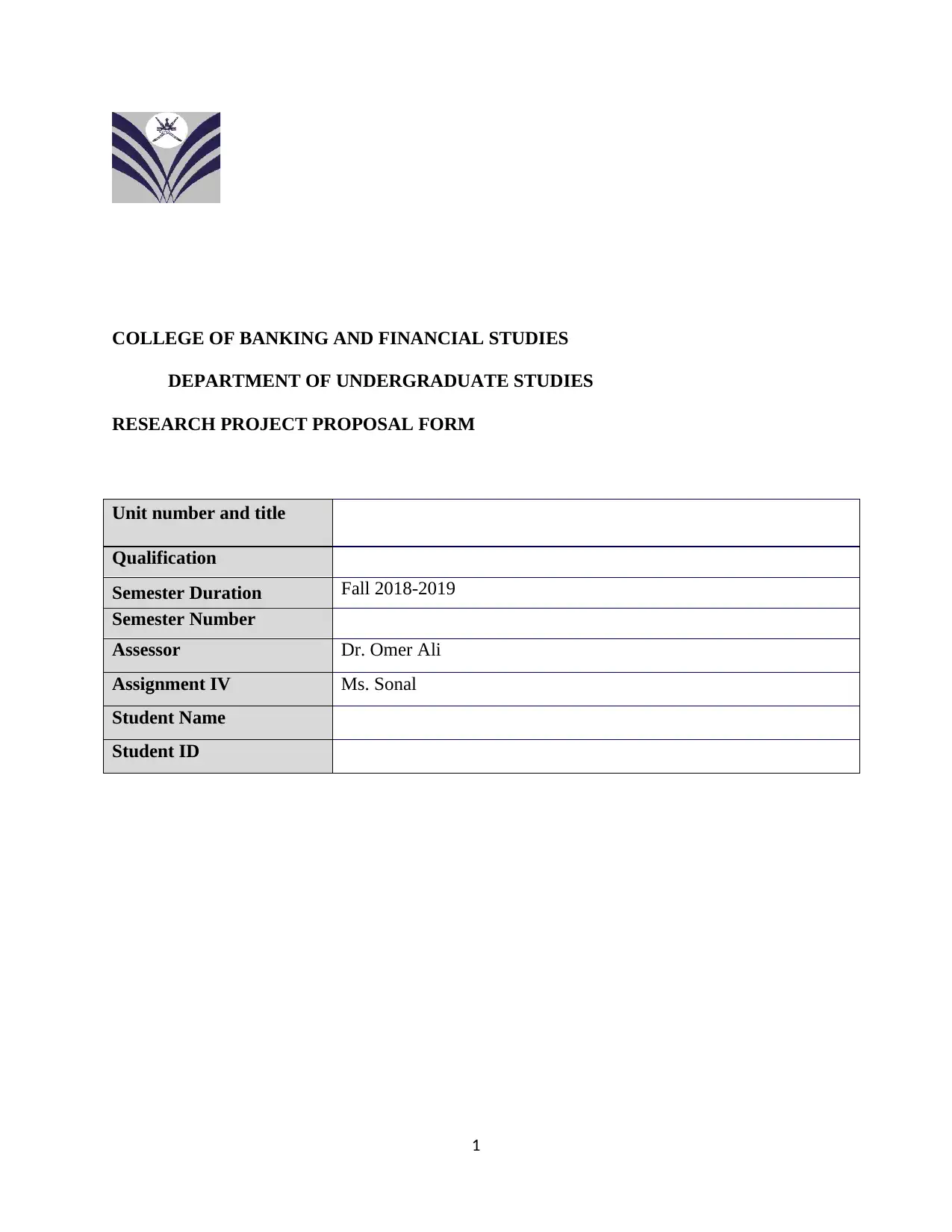
COLLEGE OF BANKING AND FINANCIAL STUDIES
DEPARTMENT OF UNDERGRADUATE STUDIES
RESEARCH PROJECT PROPOSAL FORM
Unit number and title
Qualification
Semester Duration Fall 2018-2019
Semester Number
Assessor Dr. Omer Ali
Assignment IV Ms. Sonal
Student Name
Student ID
1
DEPARTMENT OF UNDERGRADUATE STUDIES
RESEARCH PROJECT PROPOSAL FORM
Unit number and title
Qualification
Semester Duration Fall 2018-2019
Semester Number
Assessor Dr. Omer Ali
Assignment IV Ms. Sonal
Student Name
Student ID
1
Secure Best Marks with AI Grader
Need help grading? Try our AI Grader for instant feedback on your assignments.
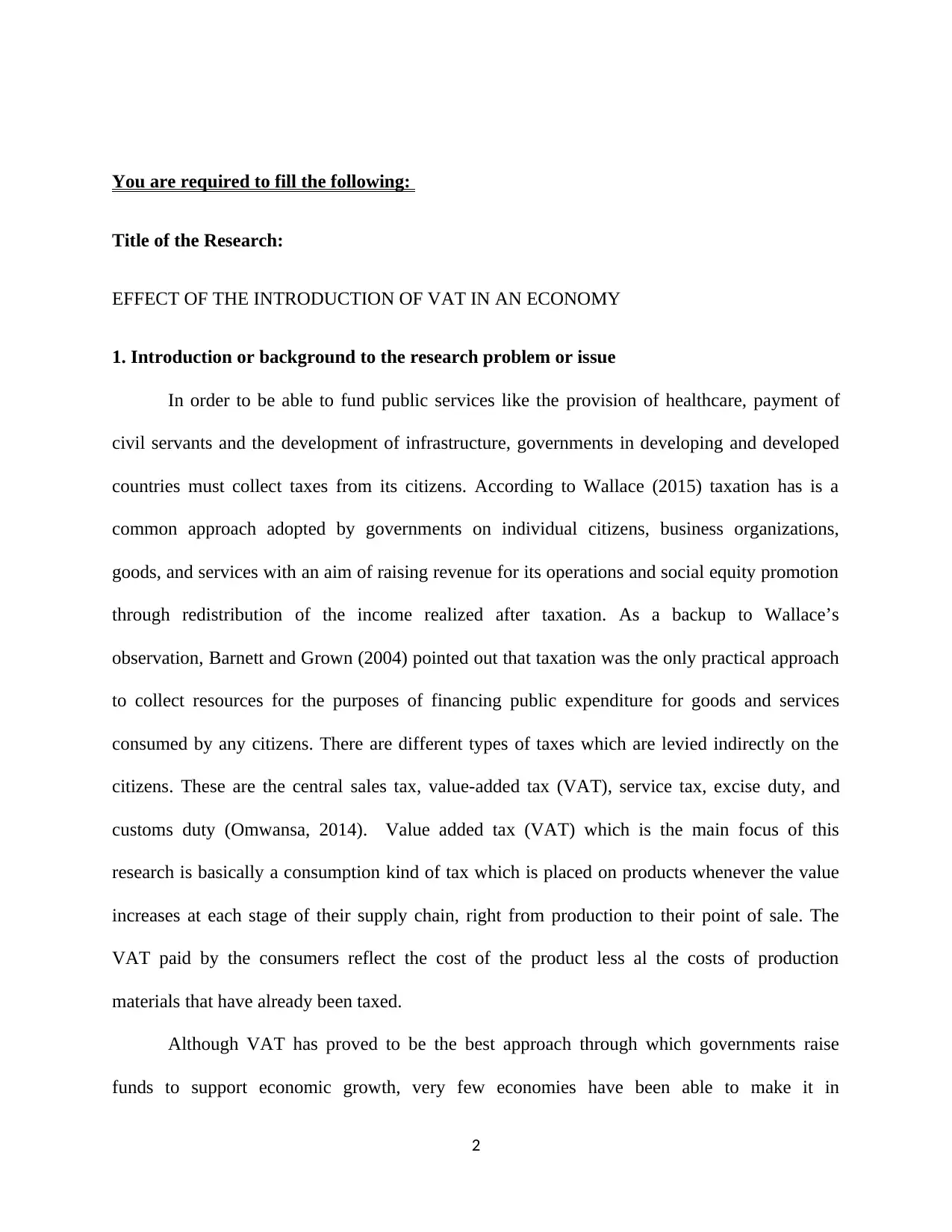
You are required to fill the following:
Title of the Research:
EFFECT OF THE INTRODUCTION OF VAT IN AN ECONOMY
1. Introduction or background to the research problem or issue
In order to be able to fund public services like the provision of healthcare, payment of
civil servants and the development of infrastructure, governments in developing and developed
countries must collect taxes from its citizens. According to Wallace (2015) taxation has is a
common approach adopted by governments on individual citizens, business organizations,
goods, and services with an aim of raising revenue for its operations and social equity promotion
through redistribution of the income realized after taxation. As a backup to Wallace’s
observation, Barnett and Grown (2004) pointed out that taxation was the only practical approach
to collect resources for the purposes of financing public expenditure for goods and services
consumed by any citizens. There are different types of taxes which are levied indirectly on the
citizens. These are the central sales tax, value-added tax (VAT), service tax, excise duty, and
customs duty (Omwansa, 2014). Value added tax (VAT) which is the main focus of this
research is basically a consumption kind of tax which is placed on products whenever the value
increases at each stage of their supply chain, right from production to their point of sale. The
VAT paid by the consumers reflect the cost of the product less al the costs of production
materials that have already been taxed.
Although VAT has proved to be the best approach through which governments raise
funds to support economic growth, very few economies have been able to make it in
2
Title of the Research:
EFFECT OF THE INTRODUCTION OF VAT IN AN ECONOMY
1. Introduction or background to the research problem or issue
In order to be able to fund public services like the provision of healthcare, payment of
civil servants and the development of infrastructure, governments in developing and developed
countries must collect taxes from its citizens. According to Wallace (2015) taxation has is a
common approach adopted by governments on individual citizens, business organizations,
goods, and services with an aim of raising revenue for its operations and social equity promotion
through redistribution of the income realized after taxation. As a backup to Wallace’s
observation, Barnett and Grown (2004) pointed out that taxation was the only practical approach
to collect resources for the purposes of financing public expenditure for goods and services
consumed by any citizens. There are different types of taxes which are levied indirectly on the
citizens. These are the central sales tax, value-added tax (VAT), service tax, excise duty, and
customs duty (Omwansa, 2014). Value added tax (VAT) which is the main focus of this
research is basically a consumption kind of tax which is placed on products whenever the value
increases at each stage of their supply chain, right from production to their point of sale. The
VAT paid by the consumers reflect the cost of the product less al the costs of production
materials that have already been taxed.
Although VAT has proved to be the best approach through which governments raise
funds to support economic growth, very few economies have been able to make it in
2
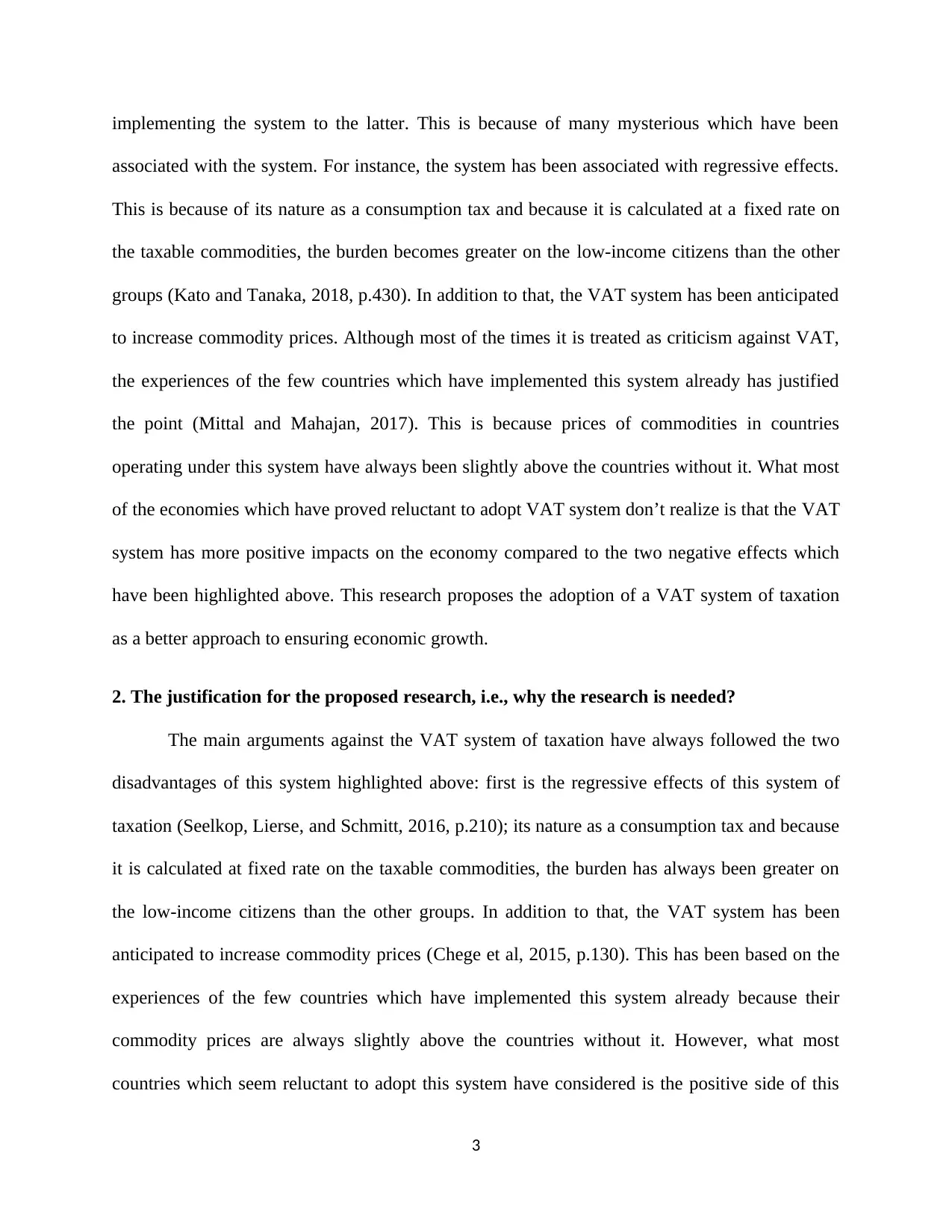
implementing the system to the latter. This is because of many mysterious which have been
associated with the system. For instance, the system has been associated with regressive effects.
This is because of its nature as a consumption tax and because it is calculated at a fixed rate on
the taxable commodities, the burden becomes greater on the low-income citizens than the other
groups (Kato and Tanaka, 2018, p.430). In addition to that, the VAT system has been anticipated
to increase commodity prices. Although most of the times it is treated as criticism against VAT,
the experiences of the few countries which have implemented this system already has justified
the point (Mittal and Mahajan, 2017). This is because prices of commodities in countries
operating under this system have always been slightly above the countries without it. What most
of the economies which have proved reluctant to adopt VAT system don’t realize is that the VAT
system has more positive impacts on the economy compared to the two negative effects which
have been highlighted above. This research proposes the adoption of a VAT system of taxation
as a better approach to ensuring economic growth.
2. The justification for the proposed research, i.e., why the research is needed?
The main arguments against the VAT system of taxation have always followed the two
disadvantages of this system highlighted above: first is the regressive effects of this system of
taxation (Seelkop, Lierse, and Schmitt, 2016, p.210); its nature as a consumption tax and because
it is calculated at fixed rate on the taxable commodities, the burden has always been greater on
the low-income citizens than the other groups. In addition to that, the VAT system has been
anticipated to increase commodity prices (Chege et al, 2015, p.130). This has been based on the
experiences of the few countries which have implemented this system already because their
commodity prices are always slightly above the countries without it. However, what most
countries which seem reluctant to adopt this system have considered is the positive side of this
3
associated with the system. For instance, the system has been associated with regressive effects.
This is because of its nature as a consumption tax and because it is calculated at a fixed rate on
the taxable commodities, the burden becomes greater on the low-income citizens than the other
groups (Kato and Tanaka, 2018, p.430). In addition to that, the VAT system has been anticipated
to increase commodity prices. Although most of the times it is treated as criticism against VAT,
the experiences of the few countries which have implemented this system already has justified
the point (Mittal and Mahajan, 2017). This is because prices of commodities in countries
operating under this system have always been slightly above the countries without it. What most
of the economies which have proved reluctant to adopt VAT system don’t realize is that the VAT
system has more positive impacts on the economy compared to the two negative effects which
have been highlighted above. This research proposes the adoption of a VAT system of taxation
as a better approach to ensuring economic growth.
2. The justification for the proposed research, i.e., why the research is needed?
The main arguments against the VAT system of taxation have always followed the two
disadvantages of this system highlighted above: first is the regressive effects of this system of
taxation (Seelkop, Lierse, and Schmitt, 2016, p.210); its nature as a consumption tax and because
it is calculated at fixed rate on the taxable commodities, the burden has always been greater on
the low-income citizens than the other groups. In addition to that, the VAT system has been
anticipated to increase commodity prices (Chege et al, 2015, p.130). This has been based on the
experiences of the few countries which have implemented this system already because their
commodity prices are always slightly above the countries without it. However, what most
countries which seem reluctant to adopt this system have considered is the positive side of this
3
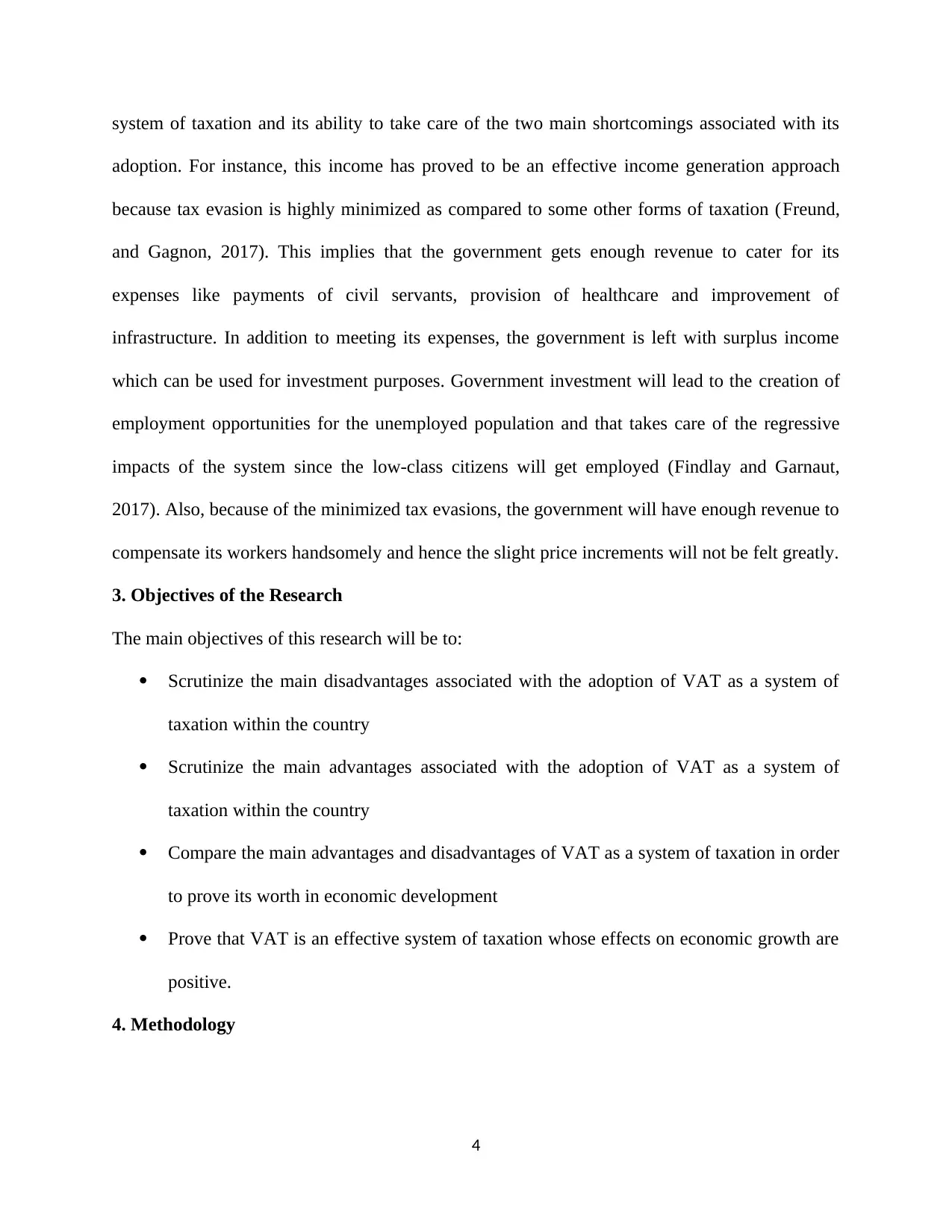
system of taxation and its ability to take care of the two main shortcomings associated with its
adoption. For instance, this income has proved to be an effective income generation approach
because tax evasion is highly minimized as compared to some other forms of taxation (Freund,
and Gagnon, 2017). This implies that the government gets enough revenue to cater for its
expenses like payments of civil servants, provision of healthcare and improvement of
infrastructure. In addition to meeting its expenses, the government is left with surplus income
which can be used for investment purposes. Government investment will lead to the creation of
employment opportunities for the unemployed population and that takes care of the regressive
impacts of the system since the low-class citizens will get employed (Findlay and Garnaut,
2017). Also, because of the minimized tax evasions, the government will have enough revenue to
compensate its workers handsomely and hence the slight price increments will not be felt greatly.
3. Objectives of the Research
The main objectives of this research will be to:
Scrutinize the main disadvantages associated with the adoption of VAT as a system of
taxation within the country
Scrutinize the main advantages associated with the adoption of VAT as a system of
taxation within the country
Compare the main advantages and disadvantages of VAT as a system of taxation in order
to prove its worth in economic development
Prove that VAT is an effective system of taxation whose effects on economic growth are
positive.
4. Methodology
4
adoption. For instance, this income has proved to be an effective income generation approach
because tax evasion is highly minimized as compared to some other forms of taxation (Freund,
and Gagnon, 2017). This implies that the government gets enough revenue to cater for its
expenses like payments of civil servants, provision of healthcare and improvement of
infrastructure. In addition to meeting its expenses, the government is left with surplus income
which can be used for investment purposes. Government investment will lead to the creation of
employment opportunities for the unemployed population and that takes care of the regressive
impacts of the system since the low-class citizens will get employed (Findlay and Garnaut,
2017). Also, because of the minimized tax evasions, the government will have enough revenue to
compensate its workers handsomely and hence the slight price increments will not be felt greatly.
3. Objectives of the Research
The main objectives of this research will be to:
Scrutinize the main disadvantages associated with the adoption of VAT as a system of
taxation within the country
Scrutinize the main advantages associated with the adoption of VAT as a system of
taxation within the country
Compare the main advantages and disadvantages of VAT as a system of taxation in order
to prove its worth in economic development
Prove that VAT is an effective system of taxation whose effects on economic growth are
positive.
4. Methodology
4
Secure Best Marks with AI Grader
Need help grading? Try our AI Grader for instant feedback on your assignments.
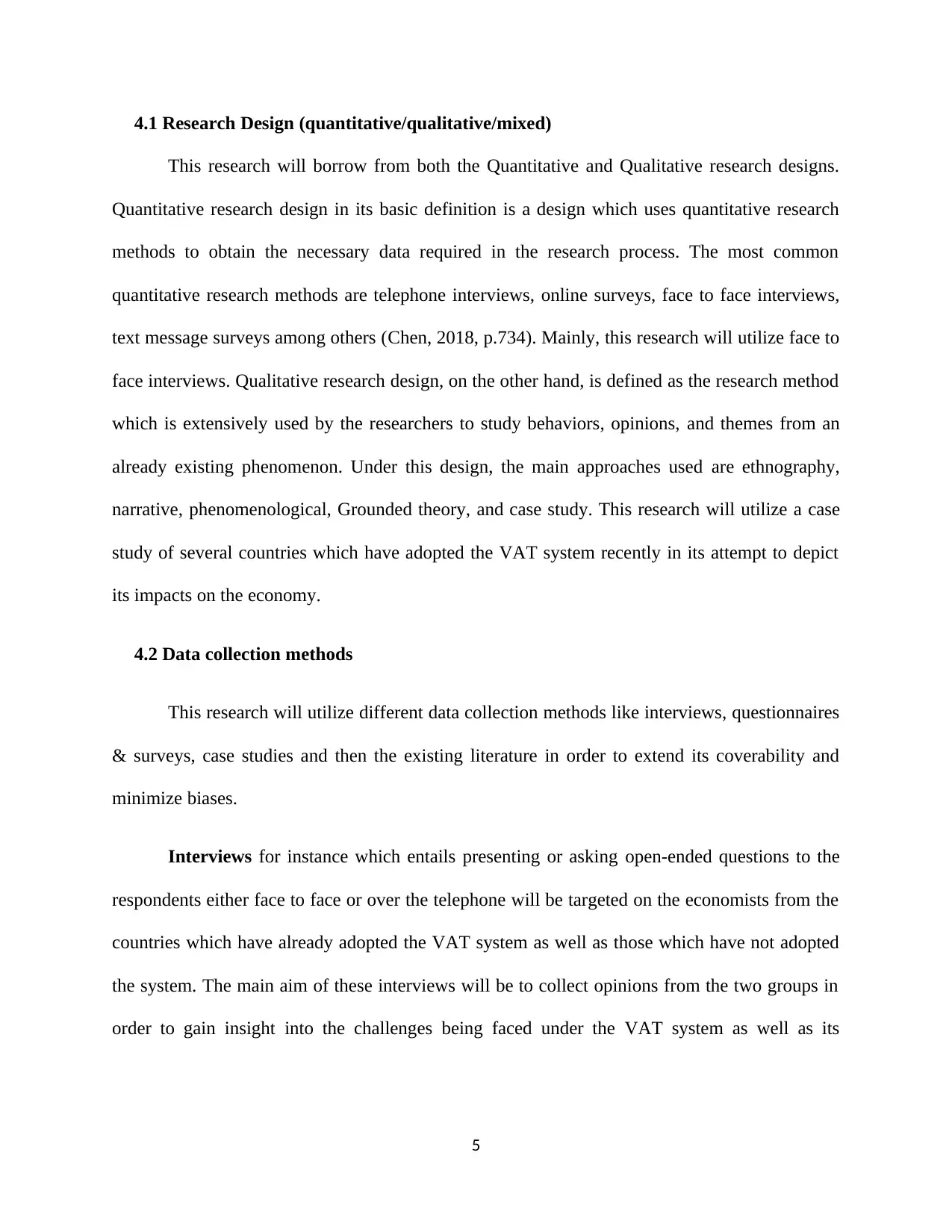
4.1 Research Design (quantitative/qualitative/mixed)
This research will borrow from both the Quantitative and Qualitative research designs.
Quantitative research design in its basic definition is a design which uses quantitative research
methods to obtain the necessary data required in the research process. The most common
quantitative research methods are telephone interviews, online surveys, face to face interviews,
text message surveys among others (Chen, 2018, p.734). Mainly, this research will utilize face to
face interviews. Qualitative research design, on the other hand, is defined as the research method
which is extensively used by the researchers to study behaviors, opinions, and themes from an
already existing phenomenon. Under this design, the main approaches used are ethnography,
narrative, phenomenological, Grounded theory, and case study. This research will utilize a case
study of several countries which have adopted the VAT system recently in its attempt to depict
its impacts on the economy.
4.2 Data collection methods
This research will utilize different data collection methods like interviews, questionnaires
& surveys, case studies and then the existing literature in order to extend its coverability and
minimize biases.
Interviews for instance which entails presenting or asking open-ended questions to the
respondents either face to face or over the telephone will be targeted on the economists from the
countries which have already adopted the VAT system as well as those which have not adopted
the system. The main aim of these interviews will be to collect opinions from the two groups in
order to gain insight into the challenges being faced under the VAT system as well as its
5
This research will borrow from both the Quantitative and Qualitative research designs.
Quantitative research design in its basic definition is a design which uses quantitative research
methods to obtain the necessary data required in the research process. The most common
quantitative research methods are telephone interviews, online surveys, face to face interviews,
text message surveys among others (Chen, 2018, p.734). Mainly, this research will utilize face to
face interviews. Qualitative research design, on the other hand, is defined as the research method
which is extensively used by the researchers to study behaviors, opinions, and themes from an
already existing phenomenon. Under this design, the main approaches used are ethnography,
narrative, phenomenological, Grounded theory, and case study. This research will utilize a case
study of several countries which have adopted the VAT system recently in its attempt to depict
its impacts on the economy.
4.2 Data collection methods
This research will utilize different data collection methods like interviews, questionnaires
& surveys, case studies and then the existing literature in order to extend its coverability and
minimize biases.
Interviews for instance which entails presenting or asking open-ended questions to the
respondents either face to face or over the telephone will be targeted on the economists from the
countries which have already adopted the VAT system as well as those which have not adopted
the system. The main aim of these interviews will be to collect opinions from the two groups in
order to gain insight into the challenges being faced under the VAT system as well as its
5
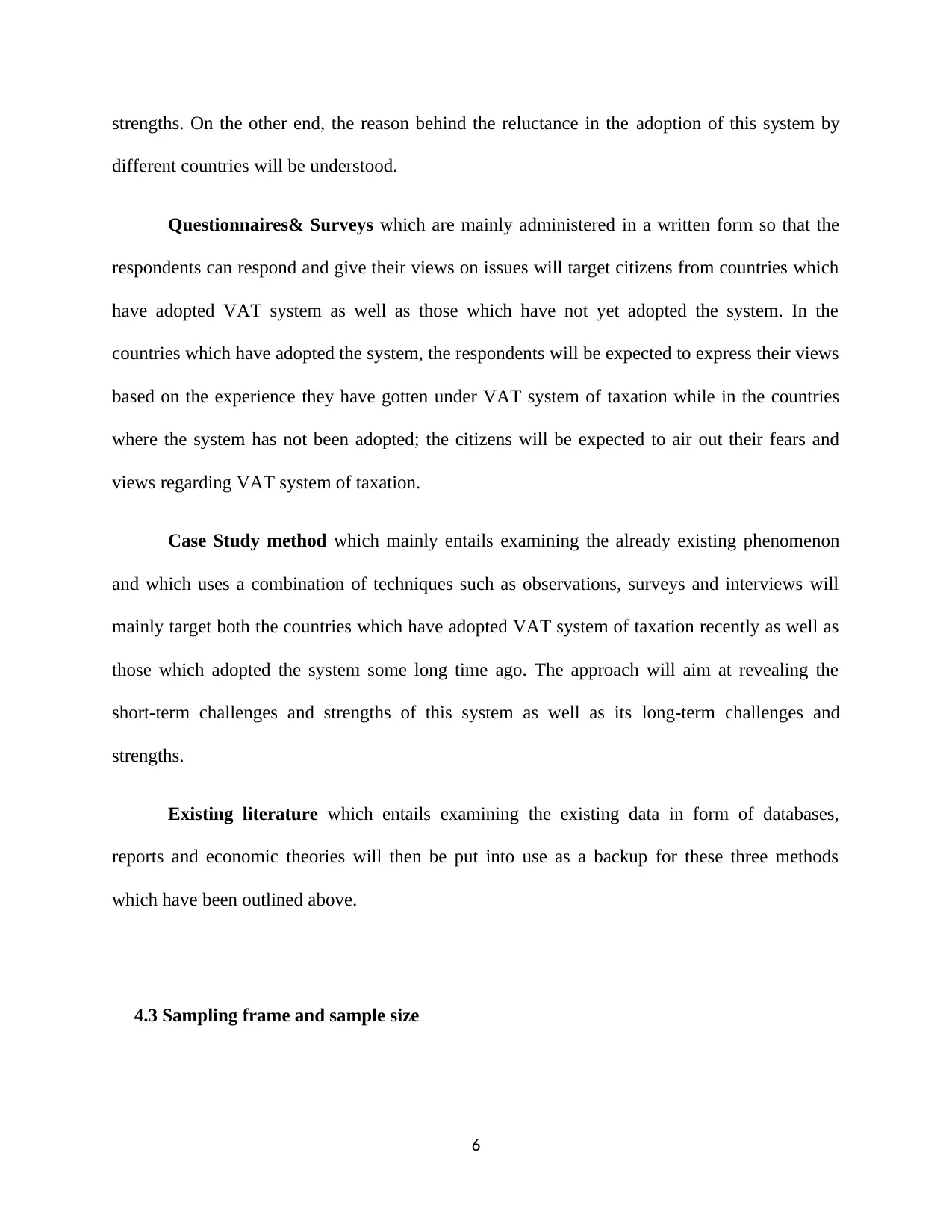
strengths. On the other end, the reason behind the reluctance in the adoption of this system by
different countries will be understood.
Questionnaires& Surveys which are mainly administered in a written form so that the
respondents can respond and give their views on issues will target citizens from countries which
have adopted VAT system as well as those which have not yet adopted the system. In the
countries which have adopted the system, the respondents will be expected to express their views
based on the experience they have gotten under VAT system of taxation while in the countries
where the system has not been adopted; the citizens will be expected to air out their fears and
views regarding VAT system of taxation.
Case Study method which mainly entails examining the already existing phenomenon
and which uses a combination of techniques such as observations, surveys and interviews will
mainly target both the countries which have adopted VAT system of taxation recently as well as
those which adopted the system some long time ago. The approach will aim at revealing the
short-term challenges and strengths of this system as well as its long-term challenges and
strengths.
Existing literature which entails examining the existing data in form of databases,
reports and economic theories will then be put into use as a backup for these three methods
which have been outlined above.
4.3 Sampling frame and sample size
6
different countries will be understood.
Questionnaires& Surveys which are mainly administered in a written form so that the
respondents can respond and give their views on issues will target citizens from countries which
have adopted VAT system as well as those which have not yet adopted the system. In the
countries which have adopted the system, the respondents will be expected to express their views
based on the experience they have gotten under VAT system of taxation while in the countries
where the system has not been adopted; the citizens will be expected to air out their fears and
views regarding VAT system of taxation.
Case Study method which mainly entails examining the already existing phenomenon
and which uses a combination of techniques such as observations, surveys and interviews will
mainly target both the countries which have adopted VAT system of taxation recently as well as
those which adopted the system some long time ago. The approach will aim at revealing the
short-term challenges and strengths of this system as well as its long-term challenges and
strengths.
Existing literature which entails examining the existing data in form of databases,
reports and economic theories will then be put into use as a backup for these three methods
which have been outlined above.
4.3 Sampling frame and sample size
6
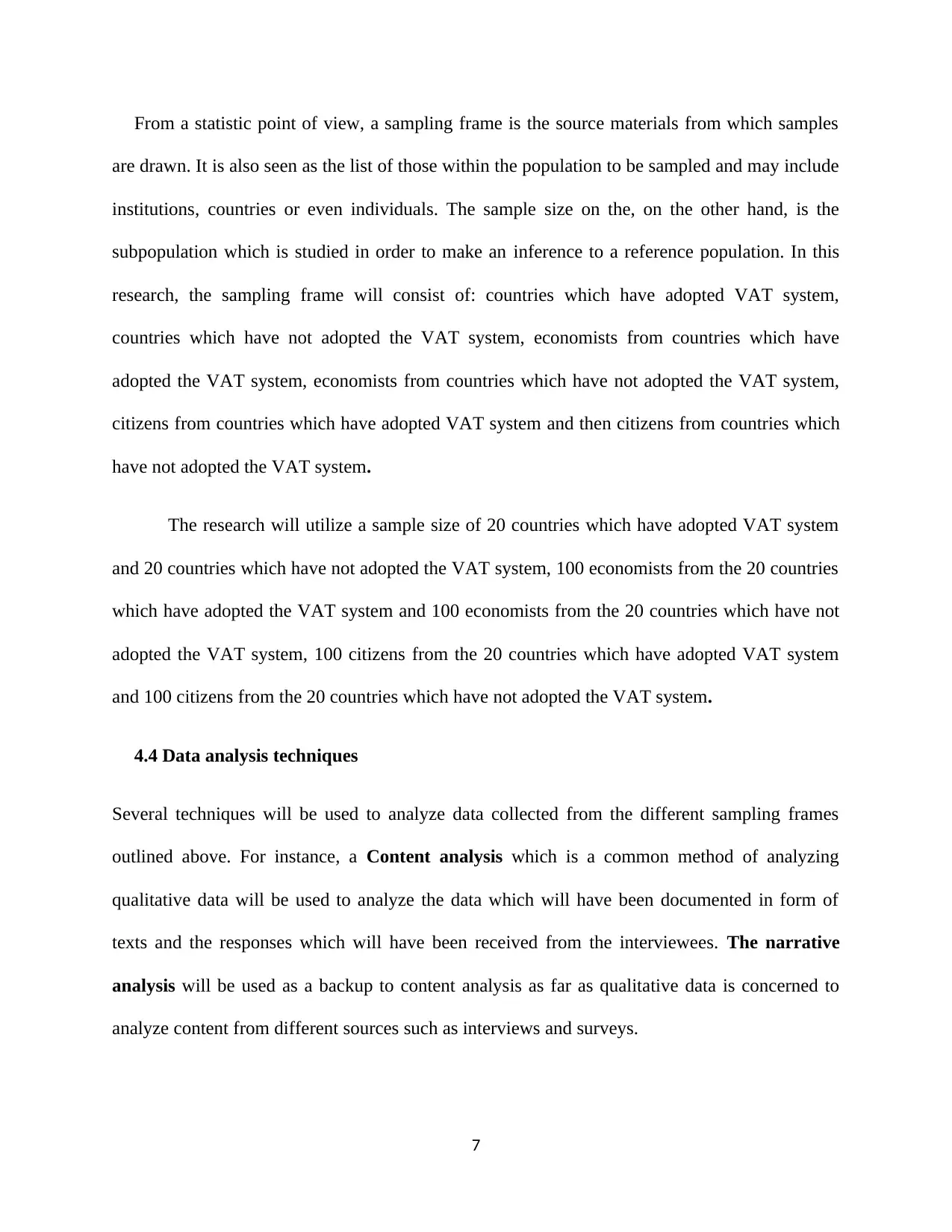
From a statistic point of view, a sampling frame is the source materials from which samples
are drawn. It is also seen as the list of those within the population to be sampled and may include
institutions, countries or even individuals. The sample size on the, on the other hand, is the
subpopulation which is studied in order to make an inference to a reference population. In this
research, the sampling frame will consist of: countries which have adopted VAT system,
countries which have not adopted the VAT system, economists from countries which have
adopted the VAT system, economists from countries which have not adopted the VAT system,
citizens from countries which have adopted VAT system and then citizens from countries which
have not adopted the VAT system.
The research will utilize a sample size of 20 countries which have adopted VAT system
and 20 countries which have not adopted the VAT system, 100 economists from the 20 countries
which have adopted the VAT system and 100 economists from the 20 countries which have not
adopted the VAT system, 100 citizens from the 20 countries which have adopted VAT system
and 100 citizens from the 20 countries which have not adopted the VAT system.
4.4 Data analysis techniques
Several techniques will be used to analyze data collected from the different sampling frames
outlined above. For instance, a Content analysis which is a common method of analyzing
qualitative data will be used to analyze the data which will have been documented in form of
texts and the responses which will have been received from the interviewees. The narrative
analysis will be used as a backup to content analysis as far as qualitative data is concerned to
analyze content from different sources such as interviews and surveys.
7
are drawn. It is also seen as the list of those within the population to be sampled and may include
institutions, countries or even individuals. The sample size on the, on the other hand, is the
subpopulation which is studied in order to make an inference to a reference population. In this
research, the sampling frame will consist of: countries which have adopted VAT system,
countries which have not adopted the VAT system, economists from countries which have
adopted the VAT system, economists from countries which have not adopted the VAT system,
citizens from countries which have adopted VAT system and then citizens from countries which
have not adopted the VAT system.
The research will utilize a sample size of 20 countries which have adopted VAT system
and 20 countries which have not adopted the VAT system, 100 economists from the 20 countries
which have adopted the VAT system and 100 economists from the 20 countries which have not
adopted the VAT system, 100 citizens from the 20 countries which have adopted VAT system
and 100 citizens from the 20 countries which have not adopted the VAT system.
4.4 Data analysis techniques
Several techniques will be used to analyze data collected from the different sampling frames
outlined above. For instance, a Content analysis which is a common method of analyzing
qualitative data will be used to analyze the data which will have been documented in form of
texts and the responses which will have been received from the interviewees. The narrative
analysis will be used as a backup to content analysis as far as qualitative data is concerned to
analyze content from different sources such as interviews and surveys.
7
Paraphrase This Document
Need a fresh take? Get an instant paraphrase of this document with our AI Paraphraser
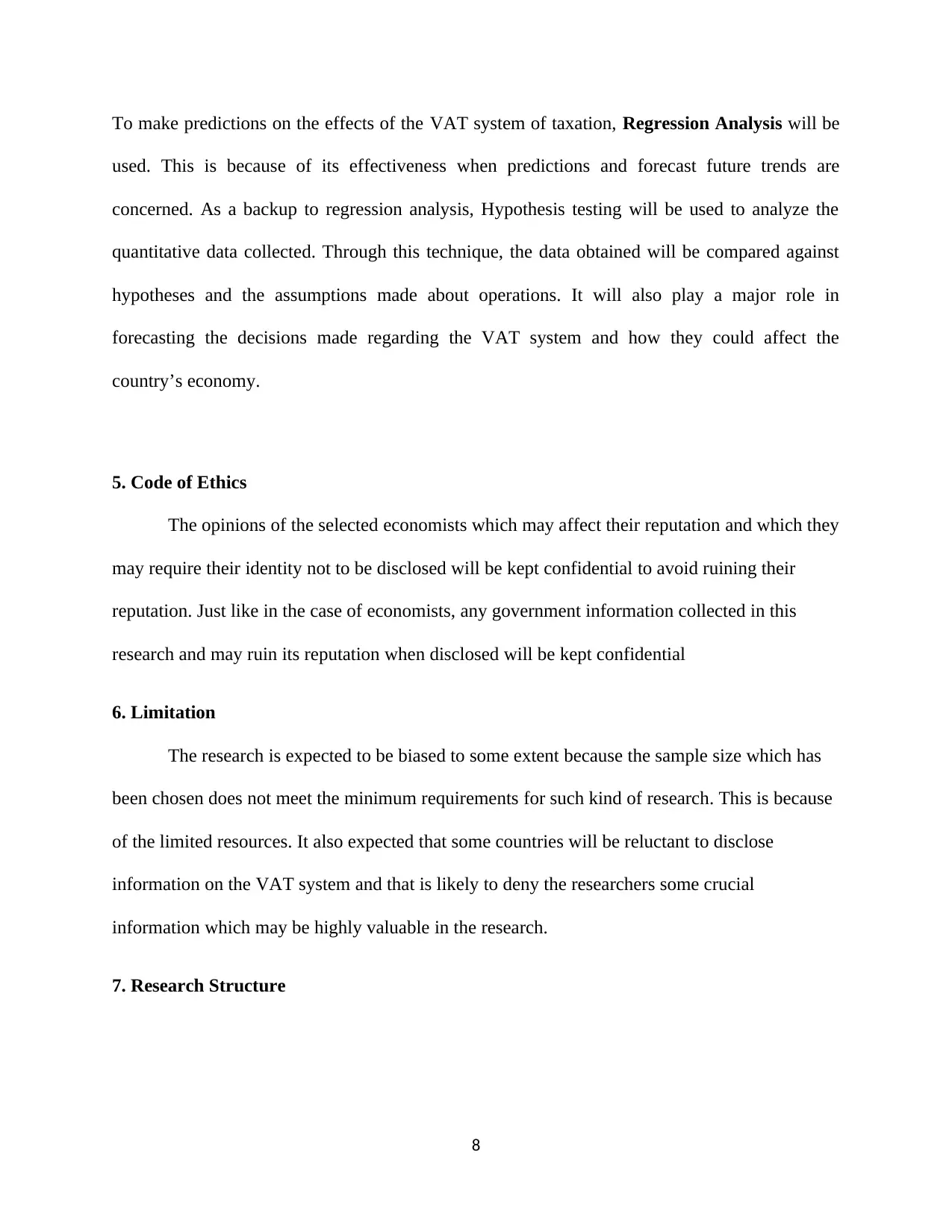
To make predictions on the effects of the VAT system of taxation, Regression Analysis will be
used. This is because of its effectiveness when predictions and forecast future trends are
concerned. As a backup to regression analysis, Hypothesis testing will be used to analyze the
quantitative data collected. Through this technique, the data obtained will be compared against
hypotheses and the assumptions made about operations. It will also play a major role in
forecasting the decisions made regarding the VAT system and how they could affect the
country’s economy.
5. Code of Ethics
The opinions of the selected economists which may affect their reputation and which they
may require their identity not to be disclosed will be kept confidential to avoid ruining their
reputation. Just like in the case of economists, any government information collected in this
research and may ruin its reputation when disclosed will be kept confidential
6. Limitation
The research is expected to be biased to some extent because the sample size which has
been chosen does not meet the minimum requirements for such kind of research. This is because
of the limited resources. It also expected that some countries will be reluctant to disclose
information on the VAT system and that is likely to deny the researchers some crucial
information which may be highly valuable in the research.
7. Research Structure
8
used. This is because of its effectiveness when predictions and forecast future trends are
concerned. As a backup to regression analysis, Hypothesis testing will be used to analyze the
quantitative data collected. Through this technique, the data obtained will be compared against
hypotheses and the assumptions made about operations. It will also play a major role in
forecasting the decisions made regarding the VAT system and how they could affect the
country’s economy.
5. Code of Ethics
The opinions of the selected economists which may affect their reputation and which they
may require their identity not to be disclosed will be kept confidential to avoid ruining their
reputation. Just like in the case of economists, any government information collected in this
research and may ruin its reputation when disclosed will be kept confidential
6. Limitation
The research is expected to be biased to some extent because the sample size which has
been chosen does not meet the minimum requirements for such kind of research. This is because
of the limited resources. It also expected that some countries will be reluctant to disclose
information on the VAT system and that is likely to deny the researchers some crucial
information which may be highly valuable in the research.
7. Research Structure
8
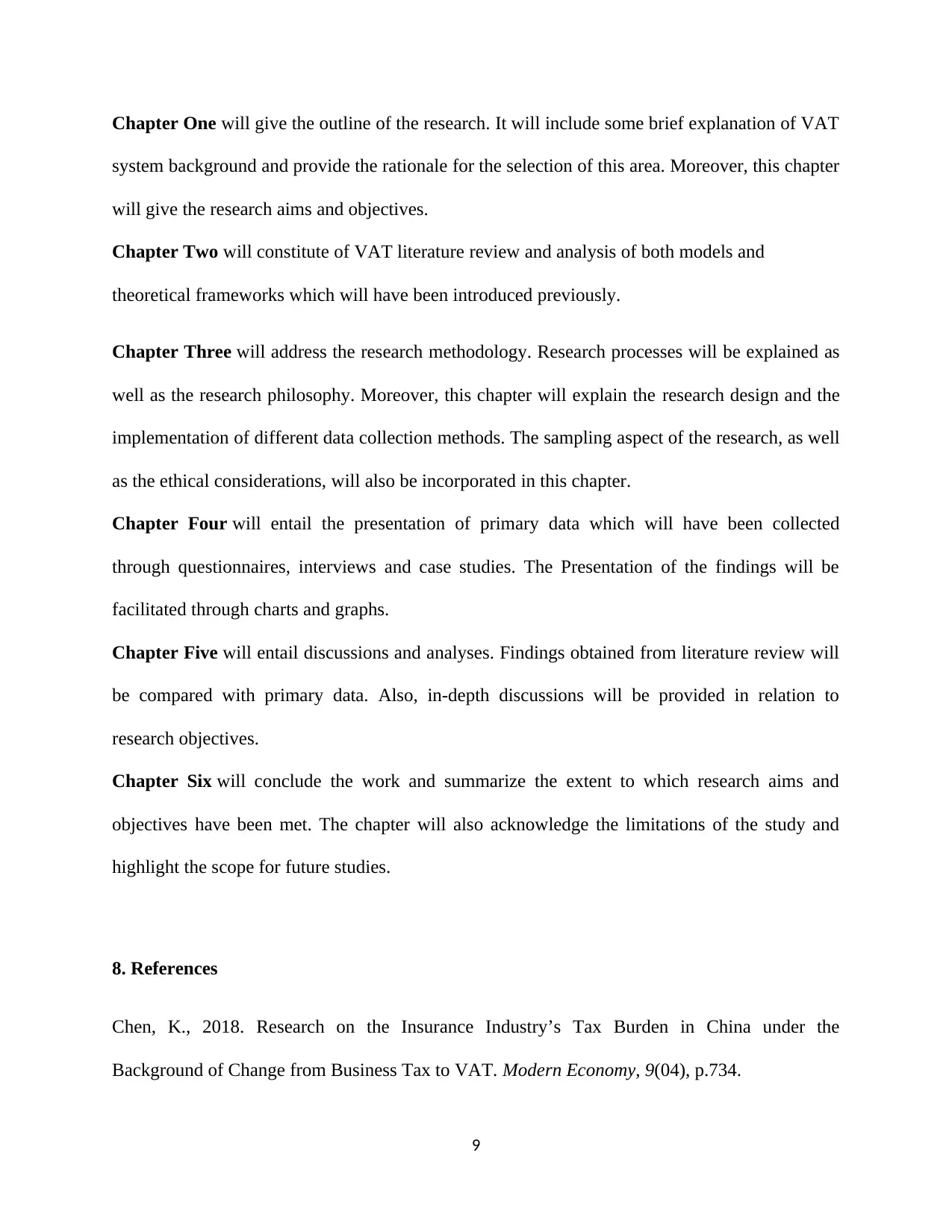
Chapter One will give the outline of the research. It will include some brief explanation of VAT
system background and provide the rationale for the selection of this area. Moreover, this chapter
will give the research aims and objectives.
Chapter Two will constitute of VAT literature review and analysis of both models and
theoretical frameworks which will have been introduced previously.
Chapter Three will address the research methodology. Research processes will be explained as
well as the research philosophy. Moreover, this chapter will explain the research design and the
implementation of different data collection methods. The sampling aspect of the research, as well
as the ethical considerations, will also be incorporated in this chapter.
Chapter Four will entail the presentation of primary data which will have been collected
through questionnaires, interviews and case studies. The Presentation of the findings will be
facilitated through charts and graphs.
Chapter Five will entail discussions and analyses. Findings obtained from literature review will
be compared with primary data. Also, in-depth discussions will be provided in relation to
research objectives.
Chapter Six will conclude the work and summarize the extent to which research aims and
objectives have been met. The chapter will also acknowledge the limitations of the study and
highlight the scope for future studies.
8. References
Chen, K., 2018. Research on the Insurance Industry’s Tax Burden in China under the
Background of Change from Business Tax to VAT. Modern Economy, 9(04), p.734.
9
system background and provide the rationale for the selection of this area. Moreover, this chapter
will give the research aims and objectives.
Chapter Two will constitute of VAT literature review and analysis of both models and
theoretical frameworks which will have been introduced previously.
Chapter Three will address the research methodology. Research processes will be explained as
well as the research philosophy. Moreover, this chapter will explain the research design and the
implementation of different data collection methods. The sampling aspect of the research, as well
as the ethical considerations, will also be incorporated in this chapter.
Chapter Four will entail the presentation of primary data which will have been collected
through questionnaires, interviews and case studies. The Presentation of the findings will be
facilitated through charts and graphs.
Chapter Five will entail discussions and analyses. Findings obtained from literature review will
be compared with primary data. Also, in-depth discussions will be provided in relation to
research objectives.
Chapter Six will conclude the work and summarize the extent to which research aims and
objectives have been met. The chapter will also acknowledge the limitations of the study and
highlight the scope for future studies.
8. References
Chen, K., 2018. Research on the Insurance Industry’s Tax Burden in China under the
Background of Change from Business Tax to VAT. Modern Economy, 9(04), p.734.
9
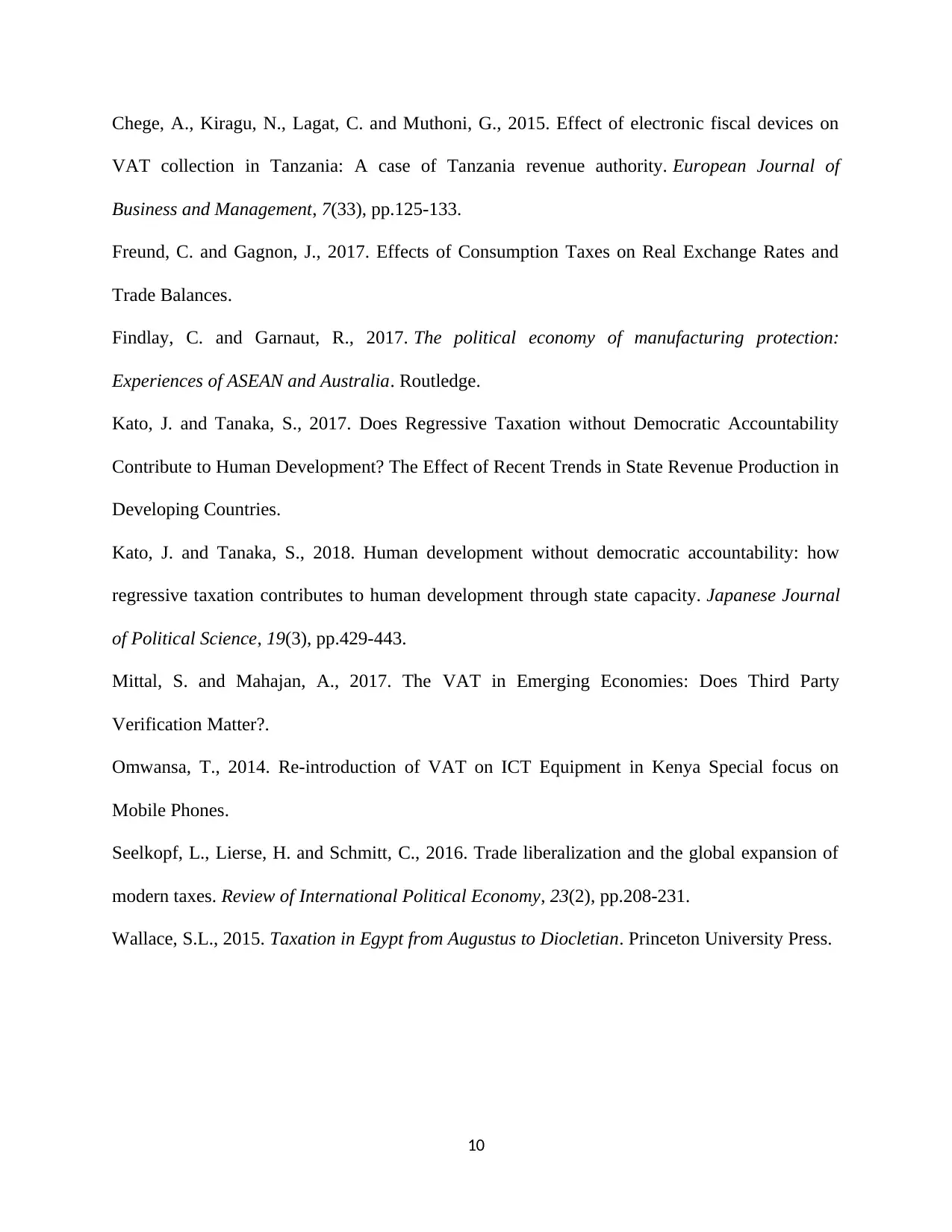
Chege, A., Kiragu, N., Lagat, C. and Muthoni, G., 2015. Effect of electronic fiscal devices on
VAT collection in Tanzania: A case of Tanzania revenue authority. European Journal of
Business and Management, 7(33), pp.125-133.
Freund, C. and Gagnon, J., 2017. Effects of Consumption Taxes on Real Exchange Rates and
Trade Balances.
Findlay, C. and Garnaut, R., 2017. The political economy of manufacturing protection:
Experiences of ASEAN and Australia. Routledge.
Kato, J. and Tanaka, S., 2017. Does Regressive Taxation without Democratic Accountability
Contribute to Human Development? The Effect of Recent Trends in State Revenue Production in
Developing Countries.
Kato, J. and Tanaka, S., 2018. Human development without democratic accountability: how
regressive taxation contributes to human development through state capacity. Japanese Journal
of Political Science, 19(3), pp.429-443.
Mittal, S. and Mahajan, A., 2017. The VAT in Emerging Economies: Does Third Party
Verification Matter?.
Omwansa, T., 2014. Re-introduction of VAT on ICT Equipment in Kenya Special focus on
Mobile Phones.
Seelkopf, L., Lierse, H. and Schmitt, C., 2016. Trade liberalization and the global expansion of
modern taxes. Review of International Political Economy, 23(2), pp.208-231.
Wallace, S.L., 2015. Taxation in Egypt from Augustus to Diocletian. Princeton University Press.
10
VAT collection in Tanzania: A case of Tanzania revenue authority. European Journal of
Business and Management, 7(33), pp.125-133.
Freund, C. and Gagnon, J., 2017. Effects of Consumption Taxes on Real Exchange Rates and
Trade Balances.
Findlay, C. and Garnaut, R., 2017. The political economy of manufacturing protection:
Experiences of ASEAN and Australia. Routledge.
Kato, J. and Tanaka, S., 2017. Does Regressive Taxation without Democratic Accountability
Contribute to Human Development? The Effect of Recent Trends in State Revenue Production in
Developing Countries.
Kato, J. and Tanaka, S., 2018. Human development without democratic accountability: how
regressive taxation contributes to human development through state capacity. Japanese Journal
of Political Science, 19(3), pp.429-443.
Mittal, S. and Mahajan, A., 2017. The VAT in Emerging Economies: Does Third Party
Verification Matter?.
Omwansa, T., 2014. Re-introduction of VAT on ICT Equipment in Kenya Special focus on
Mobile Phones.
Seelkopf, L., Lierse, H. and Schmitt, C., 2016. Trade liberalization and the global expansion of
modern taxes. Review of International Political Economy, 23(2), pp.208-231.
Wallace, S.L., 2015. Taxation in Egypt from Augustus to Diocletian. Princeton University Press.
10
Secure Best Marks with AI Grader
Need help grading? Try our AI Grader for instant feedback on your assignments.

Learner Declaration
I, certify that this assignment is my own work and not copied or plagiarized. It has not
previously been submitted as part of any assessment for this qualification. All the sources, from
which information has been obtained for this assignment, have been referenced. (Harvard
format).
I further certify that I have read and understood the College of Banking and Financial Studies
rules and regulations about plagiarism and I agree to be bound by them.
Student signature: ___________________________
Date:------------------------------------------
11
I, certify that this assignment is my own work and not copied or plagiarized. It has not
previously been submitted as part of any assessment for this qualification. All the sources, from
which information has been obtained for this assignment, have been referenced. (Harvard
format).
I further certify that I have read and understood the College of Banking and Financial Studies
rules and regulations about plagiarism and I agree to be bound by them.
Student signature: ___________________________
Date:------------------------------------------
11
1 out of 11
Related Documents
Your All-in-One AI-Powered Toolkit for Academic Success.
+13062052269
info@desklib.com
Available 24*7 on WhatsApp / Email
![[object Object]](/_next/static/media/star-bottom.7253800d.svg)
Unlock your academic potential
© 2024 | Zucol Services PVT LTD | All rights reserved.





